With dynamic pricing, you can stay competitive and better respond to market trends. In this chapter, learn how to make adjustments to your product pricing and optimise your pricing strategy for the best results in a dynamic marketplace.
How do I check price updates?
Dropshipzone Suppliers are invited to review their prices and postage rates on a fortnightly basis. This helps products maintain their competitiveness in the market.
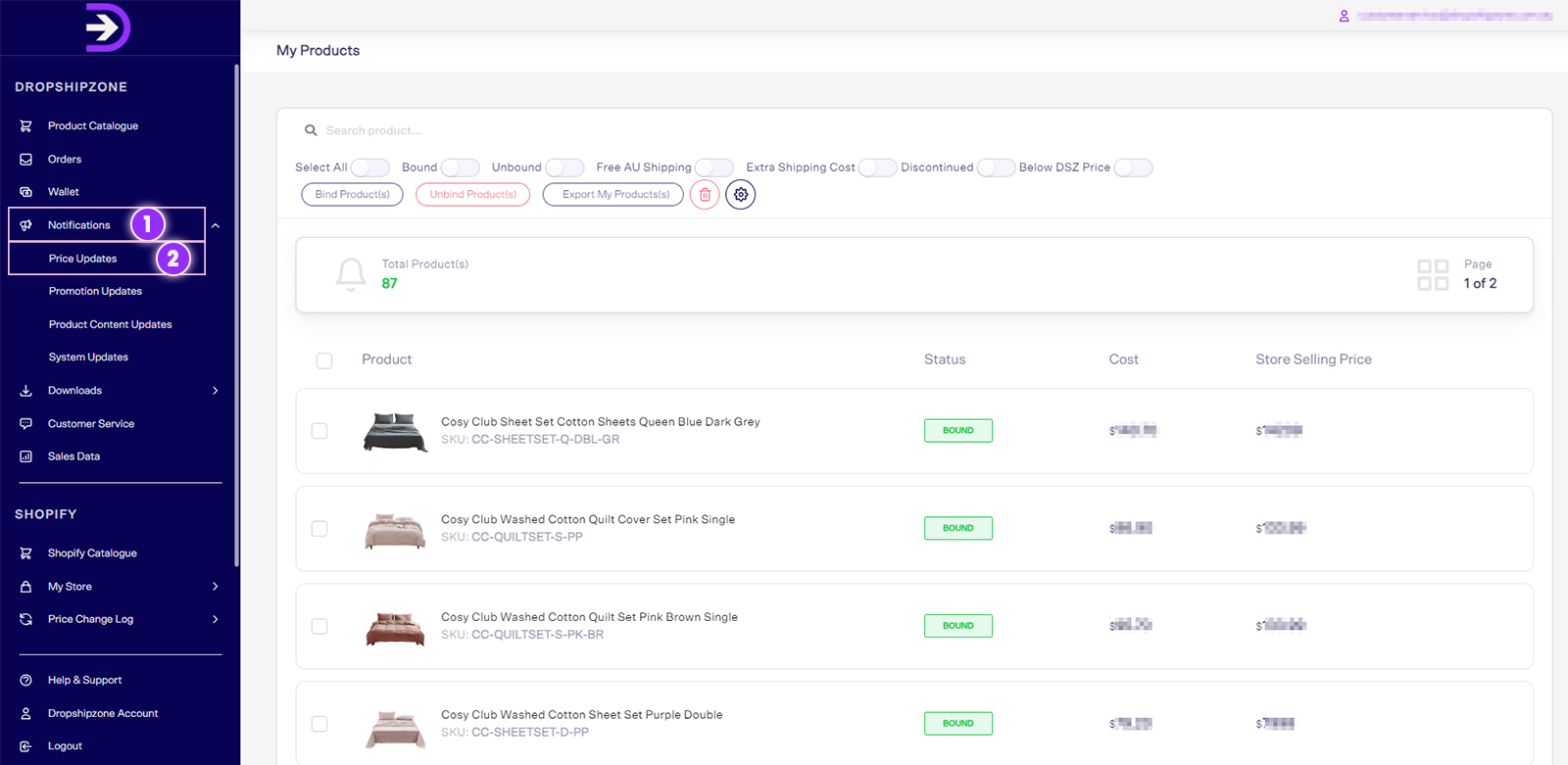
We send notifications via email to keep you informed about price updates. In case you miss any price-related notifications, navigate to the Notifications tab in the Dropshipzone section and click Price Updates to view previous records. You can subscribe to Dropshipzone price updates notifications here. We strongly recommend you check and update your prices at least weekly to prevent any discrepancies and maintain your competitiveness.
How do I check promotion updates?
Dropshipzone invites Suppliers to participate in Promotion Service events on a regular basis. For these events, Suppliers offer their products at promotional prices for a defined and limited time period. We highly encourage you to take advantage of promotional offers to discover new products and maximise your sales.
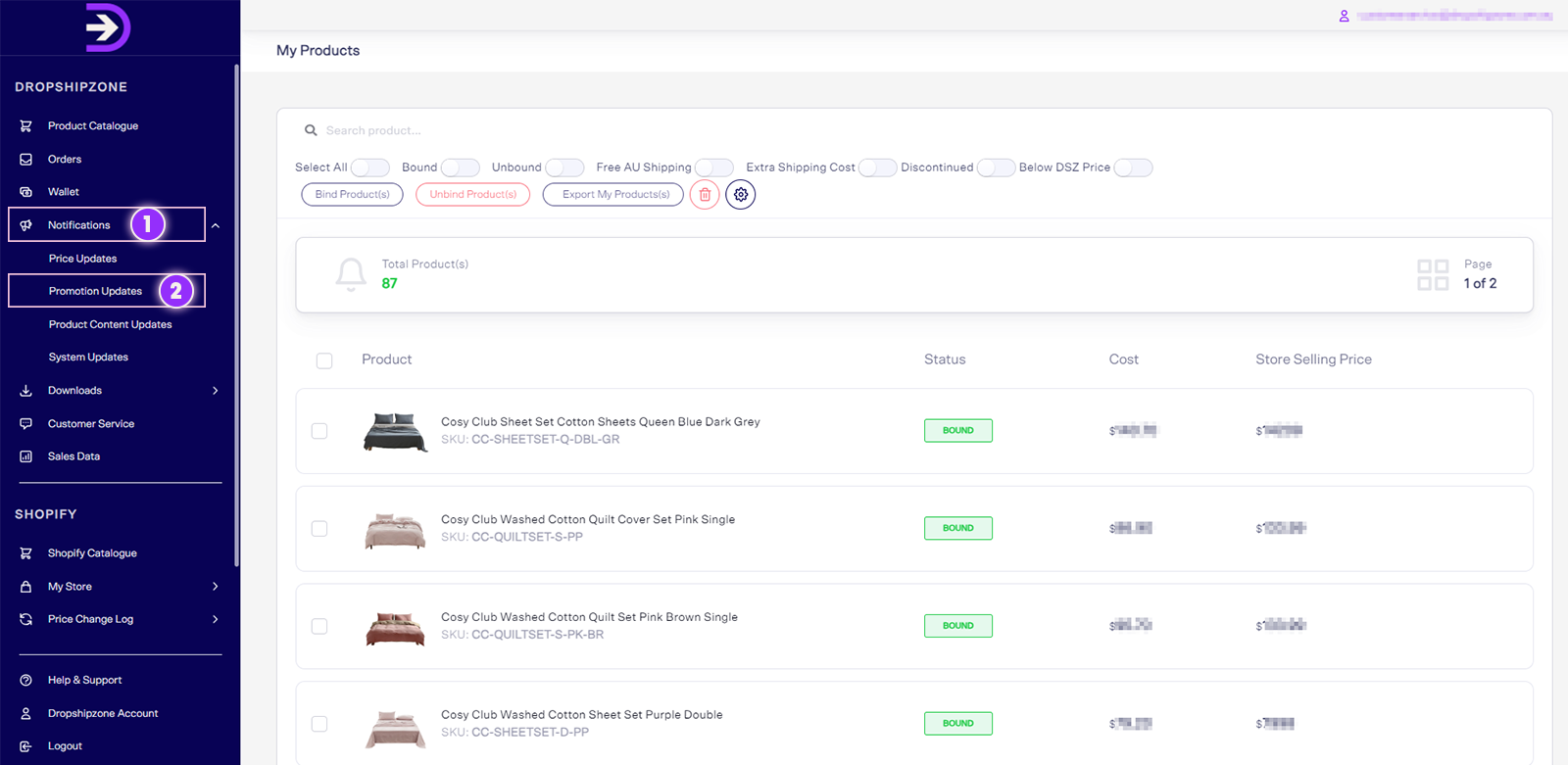
We send notifications via email to keep you informed about upcoming Promotion Service events. In case you miss these notifications, navigate to the Notifications tab in the Dropshipzone section and click Promotion Updates to view records of promotional events. You can subscribe to Dropshipzone promotion updates notifications here. Please make sure to check your notifications to keep track of promotional events.
Using Shopify? Here’s how to update Dropshipzone prices automatically
How do I enable Auto Price Sync?
Auto Price Sync allows for more efficient price syncing across Shopify and Dropshipzone. It automatically updates product prices, including during promotional events and price updates, without needing to change prices manually.
Note: You will need to contact your Dropshipzone Account Manager to turn off Auto Price Sync.

- To enable Auto Price Sync, click Auto Price Sync in the Shopify section.
- Then, scroll to the end of the page and click the button adjacent to Turn on Auto Price Sync.

Once you’ve enabled Auto Price Sync, any changes you make to the Merchant Pricing Rules, will reflect on the Auto Price Sync dashboard. Here, you can see upcoming, in progress and completed price updates. Additionally, you’ll know what triggered automatic price updates -
- Markup change: This occurs due to changes to the price markup rules and will update pricing for any SKUs affected.
- Promotion start: This occurs due to promotional service events and will update pricing for SKUs that are included in the event.
- Promotion end: This occurs at the end of a promotional service event and restores pricing back to the original price.
- Price review: This occurs during price update events and updates pricing for relevant SKUs.
You can find more information about the new changes you make on the Auto Price Sync dashboard by clicking on the Sync Details button or by exporting the CSV file.
There are three types of update notifications that you may receive.
- Updated: This indicates all SKU prices were updated successfully.
- Shopify to reattempt: This indicates an error on Shopify. Shopify will reattempt to update later.
- Need action: This indicates that some SKUs have failed to update. Users will need to download the CSV file to view the error in more detail.
How do I set up pricing rules?
With automated pricing, you can create pricing rules that dynamically adjust your product prices. You can set your own pricing rules depending on your desired profit margin. Read on to find out how you can create, customise, and manage pricing rules.
- Navigate to the Settings section within the dashboard, and click Merchant Pricing Rules.
- Click Add Rule in the upper-right corner of the Merchant Pricing Rules box. Here you can set desired markup percentages for products within different price ranges.
Imagine you offer a range of products on your online store, each priced between $100 to $2000. You can group the products into distinct price ranges and set different markup percentages to each. For instance, you might consider setting a 10% markup for products valued from $100 to $300, and a 15% markup for those priced between $300.01 and $500. Make sure the highest price you set in the first price rule should also be the lowest price you set in the next price rule, however, consider adding “.01” to the lowest price in the next rule (as shown above) to maintain a clear and distinct pricing structure. It's like connecting the two rules together without any price conflicts.
- To set Pricing Rules for your products, enter the desired price range in the DSZ Price Range column and specify the desired markup percentage. You can even add the end figure in cents (for example, $1.99) for your price. Make sure to create pricing rules that cover all the different price points within your product range on Dropshipzone.
- Once you’ve updated the pricing rules, click the Save button. The selling prices of the products in your store will change based on the markup you've set.
Please note that if the pricing rules are updated, the SKU prices will also be updated.
Note:
You’ll see two formulas on the Merchant Pricing Rules page. These formulas are essential for pricing and profit analysis in your ecommerce business.
The first formula (Dropshipzone calculation: Selling price in your Shopify store = (1 + Markup %) ✕ DSZ price) helps determine the selling price of a product in your Shopify store. For example, if the Dropshipzone product price is $50 and your markup percentage is 20%, the calculation would be: Selling price = (1 + 0.20) * $50 = $60.
The second formula (Shopify calculation: Shopify margin % = (selling price - cost) / selling price) helps determine the profit margin percentage for a product in your Shopify store. You take the difference between the selling price and the cost (which is the Dropshipzone product price) and divide that difference by the selling price. For example, if the selling price is $60 and the cost (DSZ product price) is $50, the calculation would be: Shopify margin % = ($60 - $50) / $60 = 0.1667, which can be expressed as 16.67% as a percentage.
Not using Auto Price Sync via Shopify? Here’s how to update prices manually
How do I update product pricing manually?
Price discrepancies can harm your brand’s reputation and credibility, leading to customer frustration, distrust, and even cart abandonment. In this section, we’ll guide you through the process of manually updating your product prices if you haven’t enabled Auto Price Sync. To enable Auto Price Sync, check out our video tutorial.

- You can update your products’ selling prices in the Price Updates tab under the Price Change Log section within Shopify.
- Start by entering the date range. Make sure to expand the date range to cover a broader period so that all updates for the products can be displayed.
- Then, simply select the SKU option and click the Apply to My Store button. You’ll receive a pop-up notification Submission Received. Any changes you make on the Price Updates page will reflect on your storefront.
The new selling price is calculated based on the pricing rules that you set. So, if you want new selling prices to comply with pricing rules, set up mark up pricing rules and enable Auto Price Sync. Once you enable Auto Price Sync, you’ll be able to see price updates in the Auto Price Sync section on the dashboard.
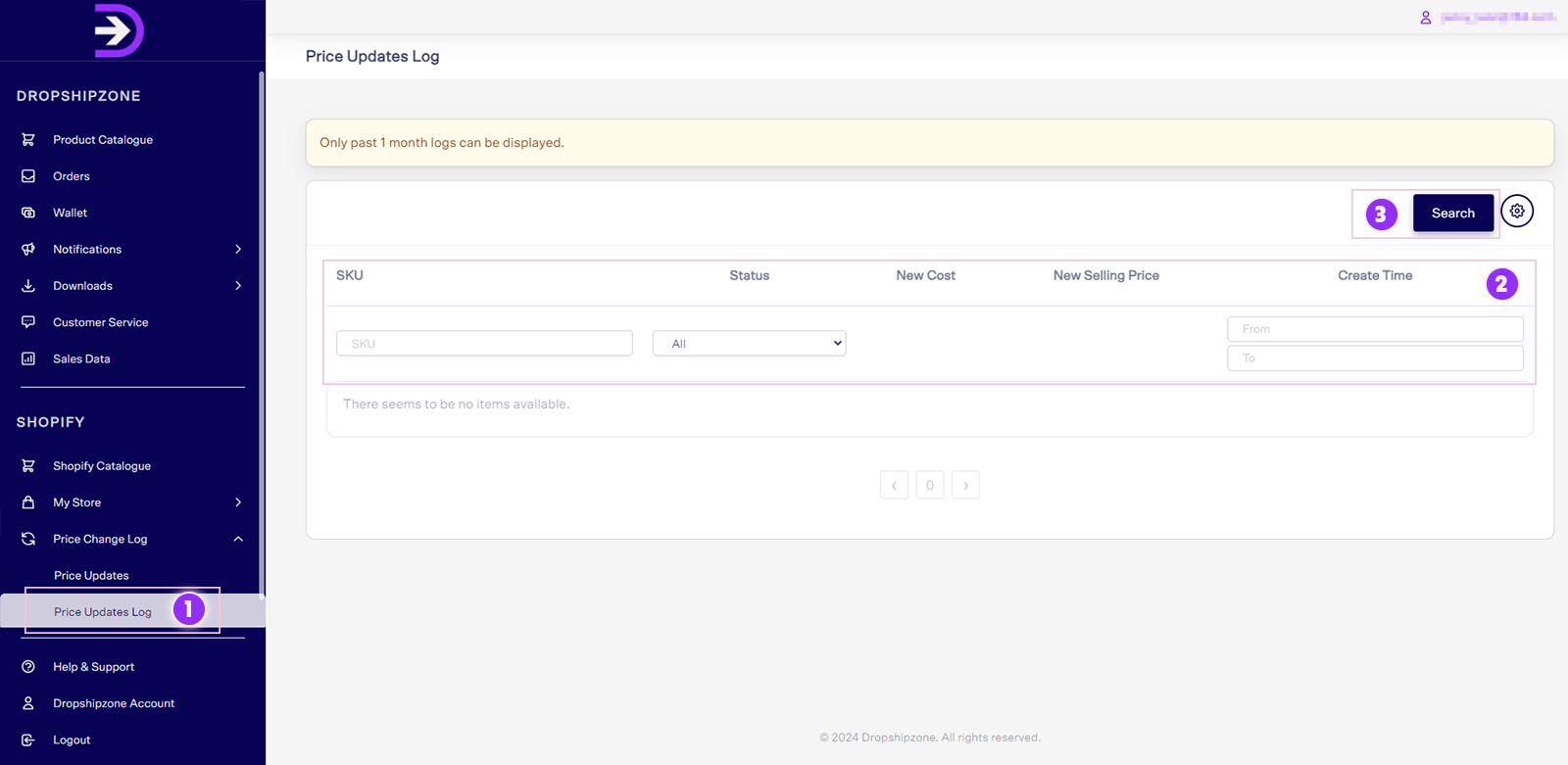
- To track your product's price update record, navigate to the Price Updates Log tab under the Price Change Log section within Shopify. However, you can check only one month's logs. You have the option to search by SKU, Status, or Create Time.
Please note that the changes made on Shopify will reflect on the Dropshipzone Shopify app, except for Product Content Updates, so it’s recommended to make changes on the app. Any changes made to product prices on Shopify will sync with the Dropshipzone Shopify app until the next price change. Hence, we advise you to enable the Auto Price Sync feature to manage your product pricing automatically. This ensures that new prices from the Supplier adjust according to your pricing rules. If the Auto Price Sync feature is activated, it replaces the prices set on Shopify. If you change your prices on Shopify, they might not follow the pricing rules. In this case, it’s the Retailer’s responsibility.
How do I update promotion pricing manually?
Promotional events present online retailers with exciting opportunities to drive sales. In this section, you’ll learn how to effortlessly update your prices based on current promotions.
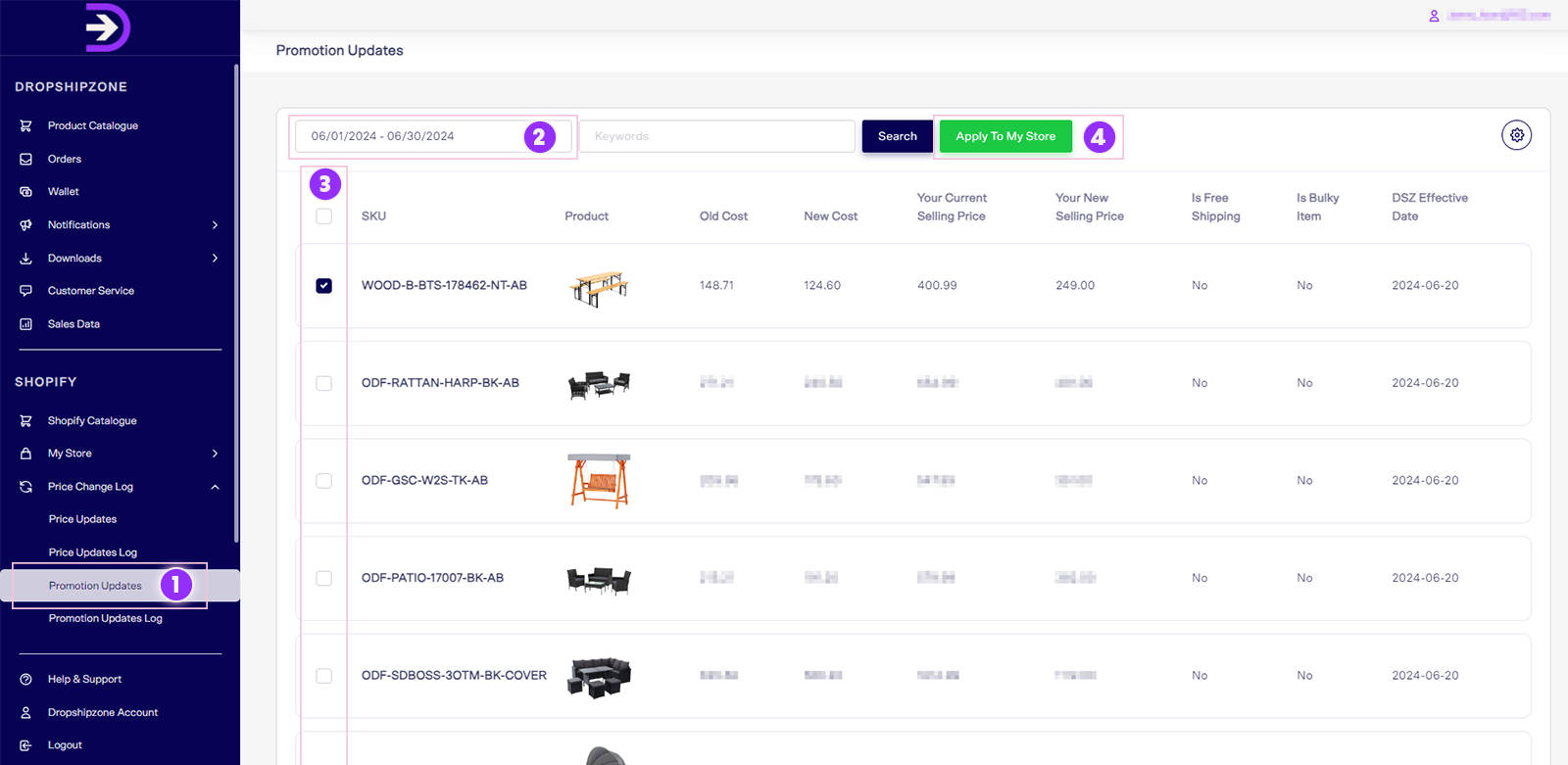
- The promotion price record will be available in the Promotion Updates tab under the Price Change Log section within Shopify once it’s ready. Ensure that you update the prices of products to the promotional prices when the promotion price record is available. You won’t be able to change the prices when the promotion period has only 2 days left to end.
- You can update your products’ selling prices in the Promotion Updates tab under the Price Change Log section within Shopify.
- Start by entering the date range. Then, select the SKU option and click the Apply to My Store button. You’ll receive a pop-up notification Submission Received when the Promotion Updates is in progress and completed.
Note: The regular price record will be ready one day prior to the promotion end date in the Promotion Updates tab under the Price Change Log section within Shopify. Once the promotion period ends, remember to change the prices back to their regular/original prices to avoid underselling.
You will get a reminder notification to update the prices. If the prices are not updated, the record will stay on the panel.
If you have enabled Auto Price Sync, your prices will be automatically updated once the promotion ends. You will also be able to see price updates in the Auto Price Sync section.
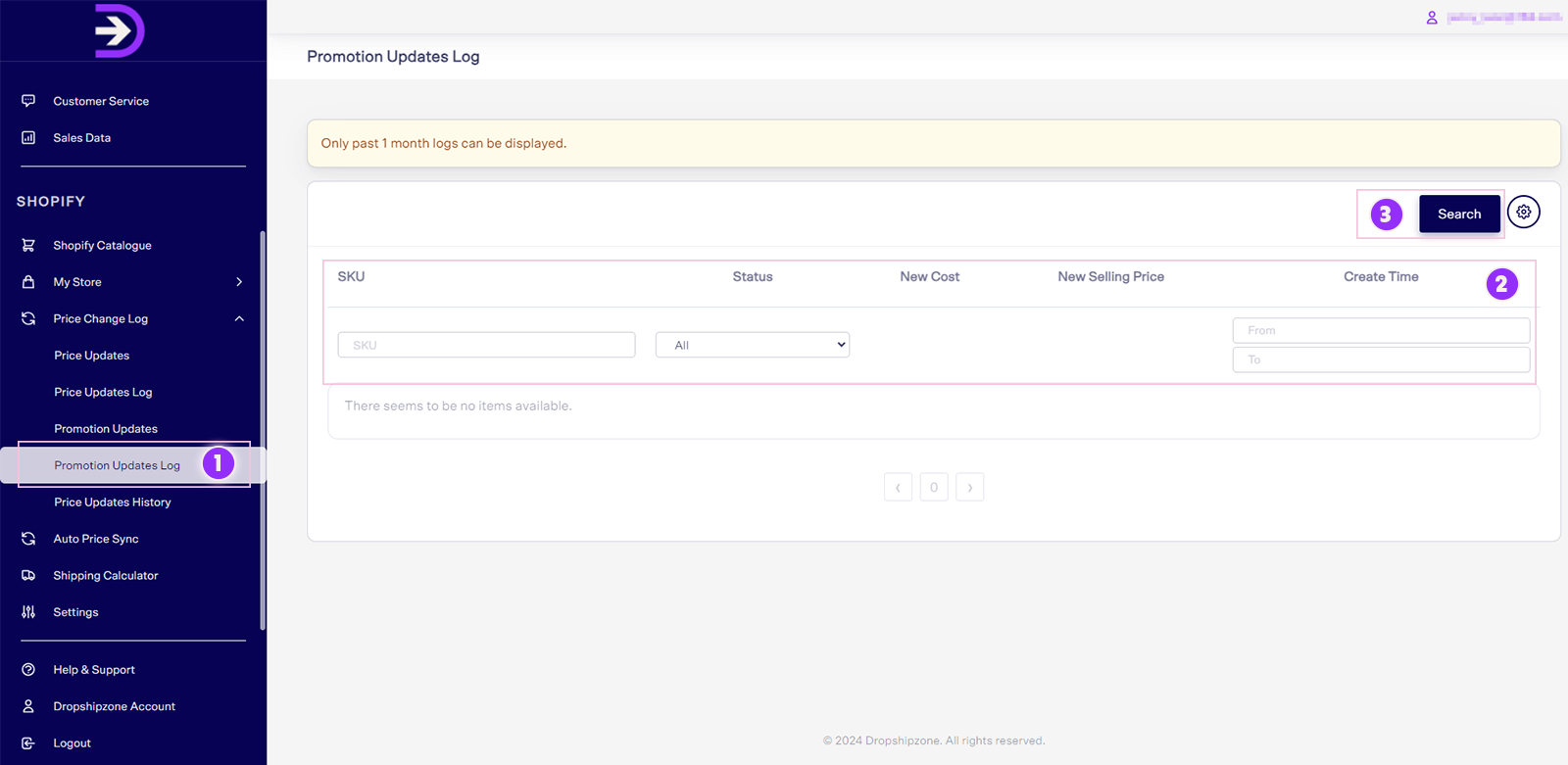
4. To track your product’s promotion price update record, navigate to the Promotion Updates Log tab under the Price Change Log section within the Dropshipzone app on Shopify. However, you can check only one month's logs. You have the option to search by SKU, Status, or Create Time. Click the Search button, and the results will display on the page.
Frequently asked questions

Dropshipzone conducts Price Update every two weeks and sends notifications via email prior to the effective day.

We coordinate Promotion Service events every two weeks for Dropshipzone Suppliers to participate in. As a Dropshipzone Retailer, make sure to check your notifications as we’ll keep you updated on promotion start and end dates.

You may get an error message when the pricing rules are not set up correctly. The pricing rules need to cover all the price ranges and be updated before importing products to your Shopify store. For more information, refer to the ‘How do I set up mark-up pricing rules?’ section.

Once Auto Price Sync is enabled, you’ll need to contact your Dropshipzone Account Manager to disable it. For more information about Auto Price Sync, check out our video tutorial.

If Auto Price Sync is enabled, existing and new SKUs will update when changes are made to pricing rules. But, if Auto Price Sync is not enabled, only newly imported SKUs will reflect the pricing rule changes. You'll need to update Shopify store’s product selling prices through Shopify Merchant manually. Then, update the pricing rules via the Dropshipzone Shopify app to make future price updates.

Variant SKUs cannot be synced. The Dropshipzone app on Shopify currently does not support variant SKUs. If you have variant SKUs, ensure each product variant has a unique SKU. You can’t use the same SKU for different variants.

To check price updates history, follow these steps:
- Navigate to the Price Updates History tab under the Price Change Log section within Shopify.
- Start by entering the date range. Then, select the All option and click the Search button. Here, you’ll see all the price updates for the selected time period.







